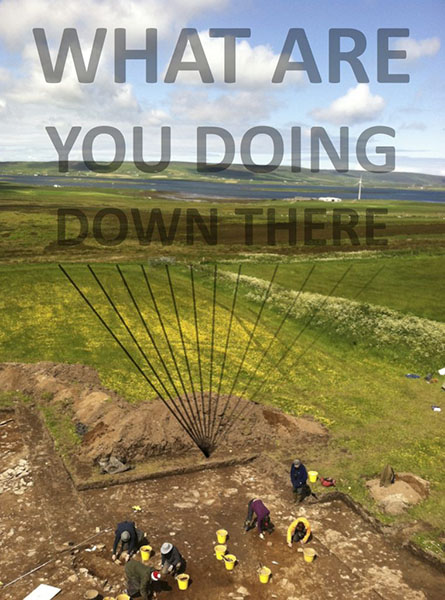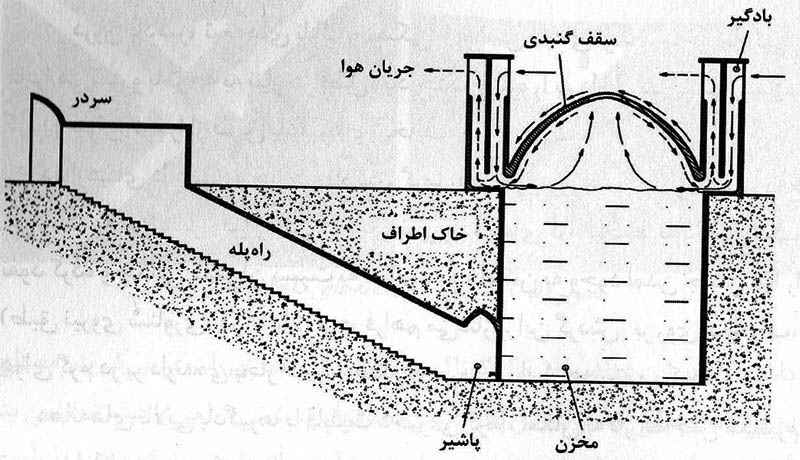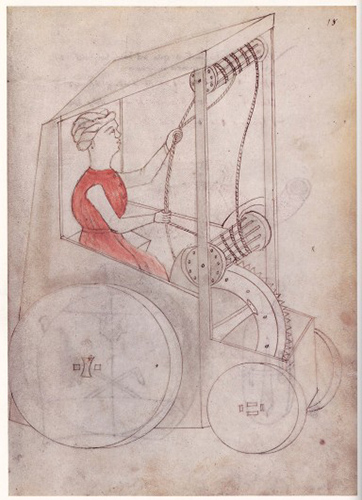Water is, among its many attributes, fluid. Left to its own devices it runs, spills, flows, leaks, crashes, and splashes. Holding H2O still is nearly impossible above 0°C. An ambitious enough goal in water management is containment and, if lucky, control. Mastery over the whims of water is of paramount concern today across a number of socio-environmental spheres—coasts flood, deserts desiccate, Flint contaminates, and California incinerates. The various infrastructural and political hydrology problems posed by Anthropocene conditions have inspired a number of technocratic and neoliberal solutions (e.g., the $118 billion storm surge gates in New York or monetization of dehydration in Africa).
A brief look at archaic relationships between water and society, however, suggests conceptual alternatives to such high-energy and high-cost survival designs. Two such examples are examined below: the gravitational plumbing at the Neolithic* site of Smerquoy in the Orkney Islands and the Persian yakhchāl, a pre-Alexandrian ‘icebox’. These cases challenge the common capitalized notion that solving environmental (or economic or technological) problems requires marshaling increasingly more energy toward them. These examples affirm that not all engineering dilemmas demand significant resource extraction and consumption, and equally that mere functional survival needn’t be the ultimate aspiration of hydrological management—low-impact lifestyles can be rather leisurely (see Soper’s alternative hedonism).
Spa Culture 5,000 BCE
Three-thousand years before Roman engineers devised the impressive urban plumbing infrastructure of the Empire’s capital, Neolithic Orcadians were splashing around in hot tubs and steaming themselves with heated stones. Perhaps a mild exaggeration (but who knows), recent excavations at the Orkney Island site Smerquoy have revealed a well-developed gravity-powered plumbing and drainage infrastructure. Smerquoy consists of a series of residences terraced into a gradual sloping hillside. The altitudinal tiering allows for the flow of ground water through ‘gutters’ into the domestic spaces. Some of the ducts at Smerquoy appear to course over burnt stones and charred areas, suggesting these residents had their choice of hot or cold running water. Further, some flows run into what appear to be collecting pools, perhaps serving as bathing areas, reservoirs for storing fresh water, or the immersion of clothes or pottery (Gee et al. 2016).

Excavating the Smerquoy site, of course.
The Orkney Islands are a seemingly endless wellspring of archaeological wonders. The Heart of Neolithic Orkney UNESCO World Heritage Site consists of two megalithic henge monuments (the Ring of Brodgar and the Stones of Stenness), the chambered Maeshowe tomb, and the Neolithic village Skara Brae. Currently under excavation in the dead center of all this Neolithic business is the massive Ness of Brodgar settlement. Orkney’s earliest farmers were clearly quite industrious, with dense villages and prodigious earthwork projects. Smerquoy appears to have had several phases of occupation and abandonment, but its earlier occupation was contemporary with or slightly older than Skara Brae and Ness of Brodgar (mid-4th century BCE). Unlike these notable coastal sites, Smerquoy is located rather inland (for an archipelago) and decidedly not on a flat expanse.
The details and precise utility of Smerquoy’s features may always remain hazy, withholding any discursive hint into their meaning for contemporaneous peoples. However, this settlement offers fertile ground for examining the relationship between (running) water and society in Neolithic Orkney. The rains come hard and heavy year-round in the cold, moist Orcadian atmosphere, providing a persistent source of flowing fresh water. The Smerquoy drainage system was well-integrated with prevailing environmental landscape features, including multiple channels coursing through the houses. Rather than attempt to dam up or keep water from entering their domestic space, these Neoliths let the water pass freely through their homes, utilizing and enjoying it as it flowed past. It has been suggested that the distinct drainage courses may have been for dirty and clean water, respectively—a sacred and a profane flow.
The stubbornly persistent Hobbesian notion of nasty, brutish, and short archaic lives has snuck its way into much archaeological interpretation over the past century, such that few would venture to suggest that the residences at Smerquoy could have been something like posh hillside spa retreats. However, if, as Gee and colleagues suggest, Smerquoy’s residential architecture is meant to reflect the expansive cairn tombs that proliferate the islands, these homes probably manifested distinct microclimates—highly insulated for trapping the heat of the hearth, yet damp and earthy, perhaps pleasantly humid given the harsh exterior conditions.
On the Rocks in the Desert
Methods of thermally-regulated hydrology also extend to the engineering of archaic ice makers (for proto-sangrias? or at least faloodeh?). First millennium BCE Persian populations were able to create and store ice in desert conditions year-round via the engineering of the yakhchāl—a domed evaporative cooler constructed from a mortar of sand, clay, egg whites, lime, goat hair, and ash. The construction material is both resistant to heat transfer and impenetrable by water. Situated next to an adjacent pool or aqueduct (qanat), water is channeled into the yakhchāl during the winter, creating enough ice to last throughout the summer. Even though air temperatures rarely go below freezing in Iranian winters, the conical design with an opening at the top funnels warmth out of the yakhchāl, creating sub-freezing temperatures inside (Soltani et al. 2012; Mahdavinejad and Javanrudi 2012). Physicists are presently attempting to utilize similar engineering principles to reduce the heat-energy required to power the planet’s air-conditioners. Today, the vast majority of capitalizing populations’ technologies for generating cold require extravagant amounts of fuel, most of which comes from combusting carbon.

Diagram of yakhchāl
Such architectural endeavors suggest a keen understanding of the thermal properties of materials—that systems are compelled toward thermal equilibrium. This knowledge was only quantified and codified among post-Enlightenment scientists in the mid-19th century. The knowledge necessary to create and store ice requires no numeric knowledge of water’s freezing point, no need of quantified thermal metrics (temperature). More immediately relevant, the yakhchāl does not require external heat to “artificially” induce thermal disequilibrium (as do refrigerators). Amazing feats of thermal engineering are quite possible without the 19th century understanding of thermodynamics derived from the steam engine (Carnot 1824).
The Landscape is a Machine
These examples of water management illustrate a novel approach to landscape mechanics that inverts the normalized relationship between control and technology that dominates (post-)industrial engineering. In Orkney the undulating landscape is a machine that powers the flow of sustenance and sanitation. With the yakhchāl the atmosphere is a machine that freezes the flow to engender summer comforts. This topographic machinery recalls the canonized simple machines (inclined plane, lever, wheel and axle, pulley, wedge, screw). These machines remind us that motive force can be attained by absence as well as presence; by removing as well as building; by liberating rather that controlling.

Renaissance sketch of automobile
The engineering deployed at Smerquoy upends the Figure-Ground relationship of technology as conceived under industrialization (McLuhan 1964). The industrially normalized relationship perceives the technology (the machine, the invention) as the Figure (steam engine) conquering the Ground (millions of years of stockpiled dead carbon). For the Orcadians the technology is the Ground (literally, the topography of the ground), which facilitates the emergence of Figures (the architecture of their homes). A similar inversion could be suggested for the yakhchāl—the technology is the Ground (the thermal differential and its pursuit of equilibrium) not the Figure. That is, the technology (the techne, operational knowledge) is the backdrop before which social contingencies are performed.
The poetic geometer Gilles Châtelet (2000) has described the horizon as a machine that unfolds velocity. In his geometry, Chatelet elaborates this into the stimulating and perplexing conclusion that distance is a surface (as opposed to a line connecting two points). The implication here is that it is not simply meters (or for that matter grams, degrees, joules, or watts) that need to be overcome in order to resolve a transition. Rather, the terrain itself works. It can work for or against the aims of human desire. Smerquoy and the yakhchāl demonstrate conscious efforts to engineer the work of the in-between (the potentiated space) toward these communities’ respective needs. While social geographers (e.g., Neil Smith & David Harvey) have extolled similar sentiments regarding distributions of political agency, Chatelet succinctly grafts the physical to the social: “No space without power!”
*The Neolithic Period denotes archaic communities that have undertaken the domestication of plants and animals, as well as sedentary living.
References
Carnot, Sadi. 1824. Reflections on the Motive Power of Heat. Paris: Bachelier.
Châtelet, Gilles. 2000. Figuring Space: Philosophy, Mathematics, and Physics. Boston: Kluwer.
Gee, Christopher, C. Richards, and M. Robertson. 2016. Local histories of passage grave building communities: Brea of Smerquoy. In Richards, C. and Jones, R. The Development of Neolithic House Societies in Orkney, 65–90. Oxford: Oxbow
Mahdavinejad, M. and Kavan Javanrudi. 2012. Assessment of ancient fridges: A sustainable method to storage ice in hot-arid climates. Asian Culture and History 4(2): 133.
McLuhan, Marshall. 1964. Understanding Media: The Extensions of Man. New York: McGraw-Hill.
Soltani, Ghazal, A. Nazari, and N. Ghanavati. 2012. Energy management in Iranian maintainable ancient architecture: Introducing ice houses and cisterns in Yazd city. Canadian Journal on Environmental, Construction and Civil Engineering 3(4): 173-8.

1 Comment
I have enjoyed reading this report about plumbing services. Really it is more useful and also helpful. I am very glad to go through this kind of informative article. Thanks for sharing a nice blog.